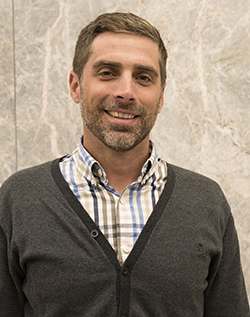By Tim Sexton, chief sustainability officer

Tim Sexton is MnDOT's chief sustainability officer. Photo by Rich Kemp |
“Minnesota can’t wait” was the theme for dozens of high school students statewide who met with Gov. Tim Walz and Lt. Gov. Peggy Flanagan on their third day in office to urge action on climate change. This meeting was on the heels of two recent reports about greenhouse gas emissions at the national and state levels.
The Rhodium Group released data on U.S. GHG emissions showing overall emissions increased 3.4 percent in 2018, breaking a recent trend of decreasing GHG emissions. For the third year in row, transportation was the number one source of GHG emissions in the U.S.
The Minnesota Pollution Control Agency released the biennial greenhouse gas emissions inventory for the state of Minnesota for 1990-2016. The big change in 2016 was that transportation replaced electricity as the largest source of GHG emissions in Minnesota as utilities shifted away from coal to lower-cost renewable energy like wind and solar.
Other key findings of the MPCA report:
- Overall GHG emissions declined 12 percent compared to 2005 levels, but Minnesota missed the state goal of a 15 percent emissions reduction by 2015.
- Electricity sector emissions are down 29 percent since 2005, almost reaching the 2025 emissions reduction goal of 30 percent relative to 2005.
- GHG emissions from transportation decreased 8 percent since 2005 and account for about 25 percent of overall GHG emissions in Minnesota.
- More than 70 percent of transportation emissions come from light-duty trucks, passenger vehicles and medium-to heavy-duty trucks.
Why does this matter?
GHG emissions are the primary driver behind the rapidly changing climate in Minnesota. The United Nations’ Intergovernmental Panel on Climate Change found that if GHG emissions continue at the current rate, the atmosphere could warm by 2.7 degrees Fahrenheit (1.5 degrees Celsius) by 2030, inundating coastlines, worsening food shortages and wildfires, and intensifying droughts and poverty. The 4th National Climate Assessment describes specific climate impacts to the U.S., including the Midwest where heavier floods could “cripple transportation networks.” Even more dire warnings come from the federal intelligence agencies saying that global systems that support modern civilization will fail if emissions go unchecked.
Minnesota has already experienced substantial warming during winter and at night, increased precipitation, including heavier downpours. For example, there were more “mega-rain” events since 2000 than in the previous 134 years combined. In the decades ahead, we can expect more of these changes, plus a higher likelihood of drought and increased summer heat. According to former state climatologist Dr. Mark Seeley, Minnesota will experience the most significant climate change in the country next to Alaska.
For MnDOT, direct impacts could include flood damage to roads, rail and aviation infrastructure, reduced pavement lifecycles, increased erosion and slope failures, more vector-borne disease affecting workers, and more winter ice (vs. snow) on roadways.
What is MnDOT doing to reduce GHG emissions from transportation?
Minnesota statute directs the Commissioner of Transportation to “minimize the degradation of air, water quality, and the climate, including reduction in greenhouse gas emissions.”
In 2016, MnDOT created the Sustainable Transportation Steering Committee direct agency sustainability and climate action. STSC is championed by Sue Mulvihill, deputy commissioner and chief engineer, and includes senior leaders from central office functional areas and districts management. STSC applied the state GHG emission reduction targets to the agencies’ internal operations (fleet fuel use, building energy use), state highway construction program and the transportation sector as a whole.
In 2018, MnDOT added a Sustainability Office to the Commissioner’s staff to make progress on the targets adopted by the STSC and support strategic efforts to help MnDOT adapt to the shocks and stresses of climate changes to the multimodal transportation system.
Example of MnDOT actions to reduce GHG emissions:
- Support adoption of zero emission electric vehicles by installing the first signs in the nation for an EV Charging Corridor (I-94), working with districts to install EV chargers and provide EVs around the state, and partnering with MPCA and the non-profit Great Plains Institute to publish an “EV Vision for Minnesota”
- Adjust facility temperature set-points and pursue solar energy contracts to save money and emissions
- Partner with five states and Federal Highway Administration to develop tools to evaluate and reduce construction GHG emissions
- Partner with Minnesota Pollution Control Agency, the Department of Commerce, the Environmental Quality Board and the McKnight Foundation to facilitate a stakeholder process and create policy options to achieve state targets for transportation GHG emissions
- Evaluate the potential to add GHG emissions analysis into project environmental review
Other efforts at MnDOT with co-benefits for climate, include CAV-X work on truck platooning, research to improve pavement life and performance, installation of living snow fences, and many others.
What’s next?
MnDOT is well-positioned to be a leader in the Midwest and nationally to create a more sustainable transportation system that leverages its technical expertise, culture of partnering and ingenuity to support a healthy climate and economy for current and future generations of Minnesotans. As the youth reminded us, when it comes to addressing climate change, “Minnesota can’t wait.” |



